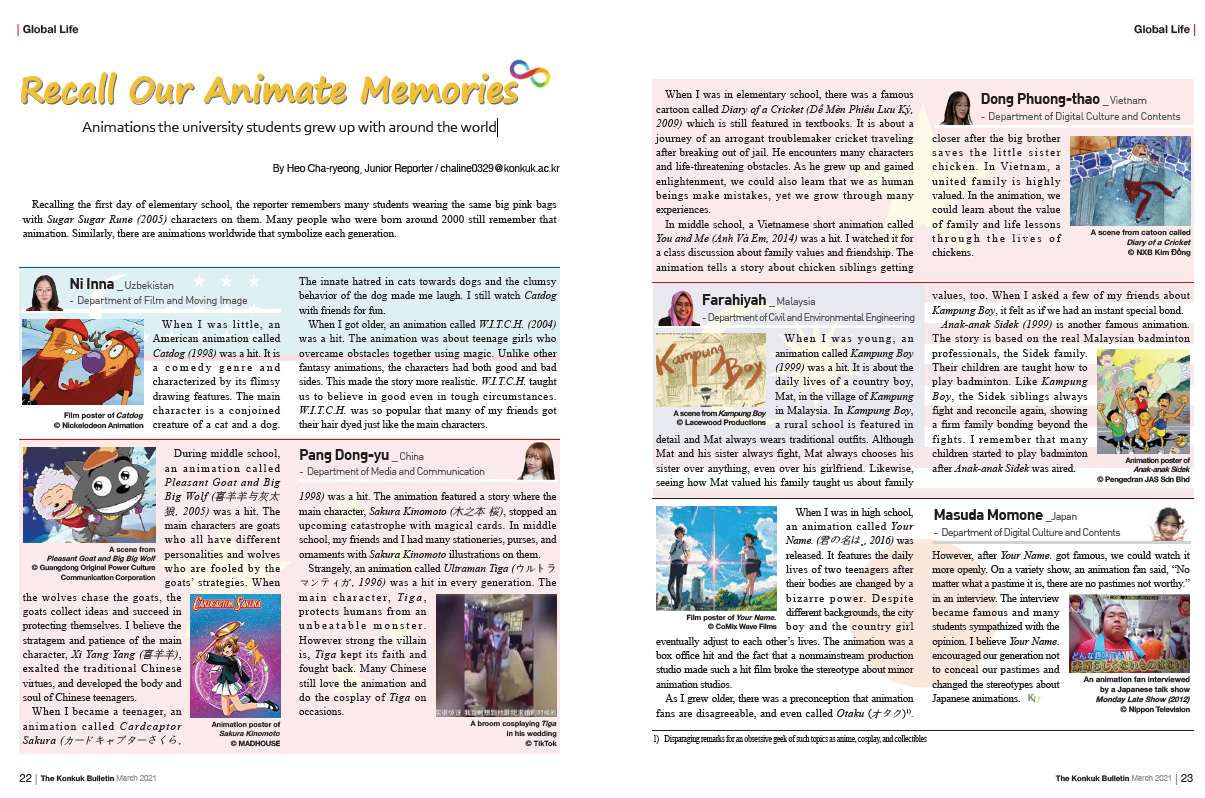Animations the university students grew up with around the world

Recalling the first day of elementary school, the reporter remembers many students wearing the same big pink bags with Sugar Sugar Rune (2005) characters on them. Many people who were born around 2000 still remember that animation. Similarly, there are animations worldwide that symbolize each generation.
Ni Inna _ Uzbekistan
- Department of Film and Moving Image
When I was little, an American animation called Catdog (1998) was a hit. It is
a comedy genre and characterized by its flimsy drawing features. The main character is a conjoined creature of a cat and a dog. The innate hatred in cats towards dogs and the clumsy behavior of the dog made me laugh. I still watch Catdog with friends for fun.
When I got older, an animation called W.I.T.C.H. (2004) was a hit. The animation was about teenage girls who overcame obstacles together using magic. Unlike other fantasy animations, the characters had both good and bad sides. This made the story more realistic. W.I.T.C.H. taught us to believe in good even in tough circumstances. W.I.T.C.H. was so popular that many of my friends got their hair dyed just like the main characters.
Pang Dong-yu _ China
- Department of Media and Communication
During middle school, an animation called Pleasant Goat and Big Big Wolf (喜羊羊与灰太 狼, 2005) was a hit. The main characters are goats who all have different personalities and wolves who are fooled by the goats’ strategies. When the wolves chase the goats, the goats collect ideas and succeed in protecting themselves. I believe the stratagem and patience of the main character, Xi Yang Yang (喜羊羊), exalted the traditional Chinese virtues, and developed the body and soul of Chinese teenagers.
When I became a teenager, an animation called Cardcaptor Sakura (カードキャプターさくら, 1998) was a hit. The animation featured a story where the main character, Sakura Kinomoto (木之本 桜), stopped an upcoming catastrophe with magical cards. In middle school, my friends and I had many stationeries, purses, and ornaments with Sakura Kinomoto illustrations on them. Strangely, an animation called Ultraman Tiga (ウルトラ マンティガ, 1996) was a hit in every generation. The main character, Tiga, protects humans from an unbeatable monster. However strong the villain is, Tiga kept its faith and fought back. Many Chinese still love the animation and do the cosplay of Tiga on occasions.
Dong Phuong-thao _ Vietnam
- Department of Digital Culture and Contents
When I was in elementary school, there was a famous cartoon called Diary of a Cricket (Dế Mèn Phiêu Lưu Ký,2009) which is still featured in textbooks. It is about a journey of an arrogant troublemaker cricket traveling after breaking out of jail. He encounters many characters and life-threatening obstacles. As he grew up and gained enlightenment, we could also learn that we as human beings make mistakes, yet we grow through many
experiences.
In middle school, a Vietnamese short animation called You and Me (Anh Và Em, 2014) was a hit. I watched it for a class discussion about family values and friendship. The animation tells a story about chicken siblings getting closer after the big brother saves the little sister chicken. In Vietnam, a united family is highly valued. In the animation, we could learn about the value of family and life lessons through the lives of chickens.
Farahiyah _ Malaysia
- Department of Civil and Environmental Engineering
When I was young, an animation called Kampung Boy (1999) was a hit. It is about the daily lives of a country boy, Mat, in the village of Kampung in Malaysia. In Kampung Boy, a rural school is featured in detail and Mat always wears traditional outfits. Although Mat and his sister always fight, Mat always chooses his sister over anything, even over his girlfriend. Likewise, seeing how Mat valued his family taught us about family values, too. When I asked a few of my friends about Kampung Boy, it felt as if we had an instant special bond.
Anak-anak Sidek (1999) is another famous animation. The story is based on the real Malaysian badminton professionals, the Sidek family. Their children are taught how to play badminton. Like Kampung Boy, the Sidek siblings always fight and reconcile again, showing a firm family bonding beyond the fights. I remember that many children started to play badminton after Anak-anak Sidek was aired.
Masuda Momone _ Japan
- Department of Digital Culture and Contents
When I was in high school, an animation called Your Name. (君の名は , 2016) was
released. It features the daily lives of two teenagers after their bodies are changed by a bizarre power. Despite different backgrounds, the city boy and the country girl eventually adjust to each other’s lives. The animation was a box office hit and the fact that a nonmainstream production studio made such a hit film broke the stereotype about minor animation studios.
As I grew older, there was a preconception that animation fans are disagreeable, and even called Otaku (オタク)1). However, after Your Name. got famous, we could watch it more openly. On a variety show, an animation fan said, “No matter what a pastime it is, there are no pastimes not worthy.” in an interview. The interview became famous and many students sympathized with the opinion. I believe Your Name. encouraged our generation not to conceal our pastimes and changed the stereotypes about Japanese animations.

